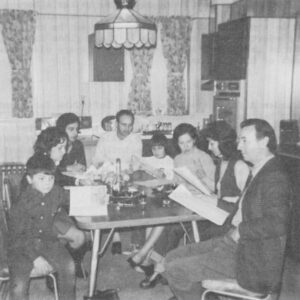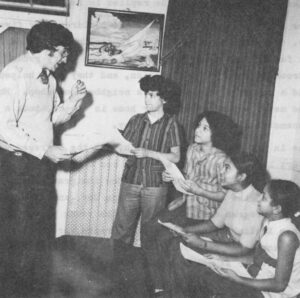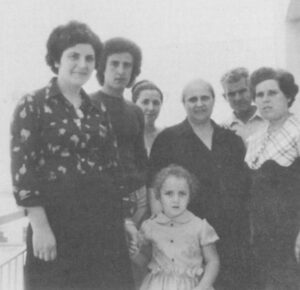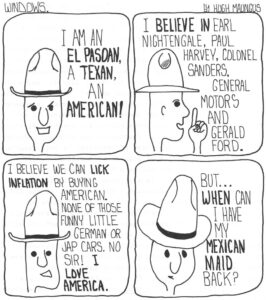Johnny Lo is 16, and he has already been working for three years as a waiter in New York City’s Chinatown. His parents left Hong Kong in 1970 so that their children could receive a free high school education in the United States, but Johnny is not likely to graduate. His restaurant shift begins at two in the afternoon, and he frequently cuts classes in the morning because he is too tired to do his homework when he returns to his apartment after midnight. His English is poor, and he is ashamed because he is two years older than most of his classmates.
Lourdes Alfonso was 11 when she left Cuba for Miami with her mother and older brother. After five years in the Miami public schools, she speaks near-perfect English. She wants to go to college and study music after graduating from high school, but she has not made any definite decisions about her future. She is disturbed because a school official has advised her that she would be better off if she looked for a “steady” job as a secretary.
Johnny Lo and Lourdes Alfonso have little in common apart from the fact that they are both recent immigrants to the United States. However, they and their families have inherited one of the most pervasive myths of American life: that the public school has served as the chief instrument of assimilation and upward mobility for everyone who has sought a new life in this country.

The myth of the school originated at the turn of the century, when the greatest surge of immigration in American history coincided with a populist expansion of educational opportunity for old and new citizens alike. It does not fit the standard dictionary definition of myth as a “purely fictitious narrative usually involving supernatural persons, actions, or events, and embodying some popular idea concerning natural or historical phenomena (Oxford Universal Dictionary).” Rather, it is one of the many secular myths that help define a community, identify people with the community and frequently move individuals to act on behalf of their community. Like many secular myths, the image of the school is an idealization of reality rather than the dictionary’s “fictitious narrative.” And it is an integral part of the larger myth of the American melting pot.
The school myth was frequently invoked during the 1960’s by critics of urban education who asked, “Why can’t the schools do for the blacks what they used to do for the immigrants?” Implicit in the question-accusation was the belief that most immigrants overcame their initial language difficulties, did well in school and used their education to move into the social and economic mainstream of American life. This traditional view of the public school, along with the melting pot thesis itself, is now being subjected to a long-overdue revisionist analysis by historians and social scientists.
The truest answer to the question of why modern schools cannot seem to help blacks as they once helped the immigrants is that the schools never accomplished as much for immigrants as Americans thought they did. New York’s school system accommodated the largest and most diverse group of immigrant children between 1880 and 1924, when Congress passed severely restrictive immigration laws that were to remain substantially unchanged for the next four decades. The city’s total school enrollment rose to nearly 800,000 between 1885 and 1900. (It is only 1.1 million today.) The new immigration was responsible for doubling the number of children in many elementary schools; most schools in immigrant neighborhoods were on double or triple sessions. Diane Ravitch, a fellow at Teachers College, Columbia University, suggests that the idea of the school as the prime instrument of assimilation did not really take hold until the beginning of this century, “In the nineteenth century.” she observes, “the public school was only one of many acculturation devices; it was expected to provide a seat for the child, lecture him on good habits, and drill into him enough schooling to get him into the world of work on a competitive, if minimal, basis. But in the early twentieth century, the public school was transformed into a vast, under financed, bureaucratic social-work agency, expected to take on single-handedly the responsibilities, which had formerly been discharged, by family, community and employer. Of course, the immigrants continued to be acculturated through work, politics, religion, the press, and their own communities, but the idea took hold that the public school was uniquely responsible for the Americanization and assimilation of the largest foreign immigration in the nation’s history.” 1
Immigrant children at the turn of the century entered schools that were considerably Iess attuned to their needs than modern schools are to the needs of blacks, Puerto Ricans and other minority groups. Children were thrown into classes where they were expected to learn English by osmosis; no one had ever heard of “English as a second language” or “bilingual education.” Everyone went to neighborhood elementary schools, and many youngsters especially immigrants — attended schools that were as ethnically segregated as today’s schools are racially segregated. Jews who packed the schools on Manhattan’s lower East Side learned English not through contact with native-born American classmates but because English was the only language their teachers spoke in class.
“It was a sink-or-swim situation,” remembers Marie Syrkin, who attended the New York public schools when she was a new immigrant herself and who taught other immigrant students between 1925 and 1948. The daughter of Russian Jewish immigrants, Dr. Syrkin says it is “nonsensical” to give the schools major credit for the success of some immigrant groups. “The immigrants who did well in school were strongly motivated to succeed in that way,” she observes. “In the case of the Jews, it’s a cliché that there was a strong emphasis on the value of education in the homes Of course, the schools were there to be taken advantage of if you were able to do it — that was the big difference between America and the old country. But the fact is that most immigrant children didn’t succeed in school at all. There was no such thing as remedial reading to help children who didn’t catch on quickly. The teachers were not as well educated as they are today. Students didn’t have access to paperback books the way they do now. So when people say, ‘Why can’t the schools do for the blacks what they did for the immigrants?’ I laugh. They should be transported in a time machine to a school on the lower East Side in 1910, and see a bewildered child who knows only Yiddish or Russian listening to an Irish teacher talk about the Revolutionary War in English. The schools are trying much harder to accommodate differences today than they did when I was a student.”
There is strong statistical evidence to support Dr. Syrkin’s viewpoint. The Jews and Chinese were the only “old” immigrants who made effective use of education in the first and second generations. Most other immigrant groups concentrated on finding work and did not begin to take schooling seriously until their third and fourth generations in the United States — when education became closely related to job opportunities.
Italians, for example, were extremely hostile to the schools — a heritage of suspicion derived from their experiences in southern Italy. Attempts to establish compulsory schooling were regarded as a plot of the northern Italian government to disrupt traditional family values, and most southern Italian peasants lived in a society so poor and isolated that it was impossible for them to see any practical value in learning to read and write. In America, Italian parents did see that basic literacy was an asset to their children but they were not interested in education on a higher and more sophisticated level. In 1911, an ethnic breakdown of New York high school graduates turned up such a small percentage of Italian-Americans with diplomas that they were regarded as “statistically insignificant.” Irish-Americans followed with only .1% graduating from high school; Americans of British descent with 10.8 per cent, and German-Americans with 15%. The highest percentages of high school graduates — 16 percent — were of Russian origin. (This group included Jews. 2 ) At the college level, the evidence was even more dramatic. In 1910, only 94 second-generation Italian-Americans were attending any institution of higher education in New York City (despite the existence of tuition-free City College). 3
Ethnic patterns in schooling had not changed significantly by the end of the 1920’s, although larger numbers of students from every group were graduating from high school. During the Twenties, about 40 per cent of all students who entered high school in New York City actually made it to graduation. (That figure does not include the huge numbers of students who dropped out before high school.) Approximately 11% of Italian-American students graduated from high school at that time. 4 The pattern persists even today. In New York, the high school dropout rate for students of Italian descent (including new immigrants) is exceeded only by the dropout rate among Puerto Rican youngsters.
During the first three decades of the twentieth century, most Americans were unconcerned about the high dropout rate. There was no national consensus about the desirability of universal high school education, much less college education. If a student dropped out of high school, his parents did not necessarily regard him as a failure. In many second-generation immigrant homes, a high school student was praised for quitting school and getting a job to increase the family income. The dropouts who were a societal norm only 40 years ago are now perceived as a social tragedy because they cannot find jobs.
Because of the massive attention focused on the problems of native American minority groups, the new immigrant today has become “the invisible student” in large urban school systems. The percentage of public school students from non-English speaking homes has increased sharply since the U.S. immigration laws were liberalized in 1965. New York City still bears the heaviest load; out of nearly 400,000 legal immigrants entering the country every year, between 75,000 and 100,000 settle in the New York area. San Francisco, Los Angeles, Chicago, Boston and Miami have also absorbed large numbers of immigrant children into their schools.
The figures on legal immigration do not begin to indicate the true numbers of immigrant children in the public schools. Every city with a large number of legal immigrants also attracts a substantial illegal immigrant population; many of the children are enrolled in public schools. (Foreign-born children of illegal immigrants are classified as illegal aliens themselves; American-born children are U.S. citizens even though their parents may have entered the country illegally.) In New York, school officials estimate there may be 75,000 illegal aliens enrolled in the city’s public schools. The U.S. Immigration and Naturalization Service would like the schools to identify illegal aliens, but the New York Board of Education has refused, “You have to look at this realistically,” says one school principal in a heavily immigrant neighborhood, “A lot of the illegal immigrants are in this city permanently. Most of them are never going to be caught and deported. A lot of these kids who are in the schools now will get married and have babies and somehow they’ll be able to legalize their status. To deny them an education now would be doing the community a disservice in the future.”
It is impossible to determine exactly how many foreign-born or American-born children of recent immigrants are attending public schools in the United States. New York, like most cities, keeps statistics on the basis of major ethnic and racial groups; those figures do not differentiate between new immigrants and the third- or fourth-generation descendants of immigrants who arrived at the turn of the century. One New York school official estimates that there will be 250,000 children of recent immigrants attending the public schools by the end of next year. 5
The massive influx of immigrants since 1965 is reflected in schools throughout the city. At P.S. 2 in Chinatown, more than half of the students are Chinese. Nearly one-third of the Chinese children were born in Hong Kong and came to the United States with their parents during the past 18 months. Another third are American-born children of parents who have arrived since 1965. When the school opened 16 years ago, the enrollment was 65 percent Puerto Rican and only 10 per cent Chinese. Chinatown had an aging population; most third- and fourth-generation Chinese families with children were moving to the suburbs. The new immigration has quadrupled the population of Chinatown in just nine years and has completely changed the ethnic and racial makeup of the schools.
Franklin D. Roosevelt High School, a modern building that opened nine years ago in the Bensonhurst section of Brooklyn, is now going through a similar transition. When the building was under construction, officials expected that the school-age population of the area would remain relatively stable. Many of the solid one and two-family houses that surround the school were owned by people whose children had grown up and moved away from the old neighborhood. Empty classroom seats could be occupied by students from outside the regular attendance zone, and FDR would be racially integrated even though it was in the midst of a white neighborhood. However, the opening of the school coincided with the unpredictable surge of new immigrants. The section is extremely popular with Italians, who are buying houses in Bensonhurst as soon as they can save enough money to move out of the poorer, more crowded sections of Brooklyn that provided them with their first homes in the United States. Bensonhurst also has an increasing number of Israeli and Haitian immigrants. Principal Philip Eisman estimates that new immigrants now account for half of the school’s enrollment. “We have a situation in the neighborhood where older people whose children are gone are being replaced by younger people who are raising families,” he says. “Most people don’t realize that the new immigration is reversing the aging trend in a lot of city neighborhoods. For the schools, it’s a huge new job. These people come with enormous expectations about the quality and the value of education in the United States.”
Like native Americans, immigrants today expect much more of the schools than they did 75 years ago, Johnny Lots parents left Hong Kong for only one reason: to give their five children a better chance at an education. His father, Chung Ching, was an unskilled laborer in Hong Kong; he works in a laundry in New York. His mothers Frances, works in a garment factory, Mr. and Mrs. Lo are extremely worried about Johnny’s problems in school, but they need the income fr9m his restaurant job to help support their four younger children. They feel they made the right decision when they left Hong Kong, because their other children are all doing well in school. Johnny’s 14-year-old sister Lee has passed the highly competitive examination for entrance to the Bronx High School of Science. “The younger children were able to learn English very fasts,” explained Frances Lo. (She used her daughter as an interpreter.) “Johnny has problems with English like his mother and father. I feel he would do better if he did not have to work, but we are unable to manage without him. But I cannot say this is the fault of America. None of our children could go to a good high school in Hong Kong; a family like ours could not afford it. I am told that the science school my daughter will attend is one of the beat in the country — better than schools that cost thousands of dollars. Maybe when my husband learns a little more English, he can get a better job and Johnny can stop working. Then he could concentrate only on his schoolbooks. But for us, the work is already worth it. Perhaps we came too late for Johnny, but our younger sons and daughters can be anything they want. Lee wants to be a doctor; none of our children could hope for that in Hong Kong.”
Groups that used to be suspicious of schools, like the Italians, have also changed their attitudes. In contrast to the Italians who came to the United States at the turn of the century, the new immigrants are as concerned about their children’s education as they are about jobs. In Italy, as in Hong Kong, parents of modest means frequently find that they cannot afford a high school education for their children. In the United States, first-generation Italian immigrants are finishing high school and entering college in larger numbers than second- and third-generation children did in the first three decades of the century. “Life is changing in Italy too,” says 20-year-old Maria Ortes, a senior at New York’s Seward Park High School. “Poor people want their children to have an education in Italy too. My parents didn’t come here to make money — they liked some things about the life there much better. They did come so that their children could go to school. They wanted us to have the best opportunities, even though it was very difficult for them to leave their home.”
For the most part, the schools have been unprepared for the impact of the new immigration. Miami, which has received special Federal aid to cope with the influx of nearly 400,000 refugees from Fidel Castro’s Cuba, is an exception. The city schools have a well-established program that teaches English as a second language until Spanish-speaking students are able to cope with regular classes. It is easy to find success stories among Cuban students in Miami. Lourdes Alfonso, the daughter of a tailor, has an A-average in her high school subjects; she was able to cope with classes in English after only six months of intensive instruction. Her brother Raul goes to high school at night; he supports Lourdes and her mother by working in an auto body shop during the day. The family was split because two older brothers were of military age and were prohibited from leaving Cuba in 1969. Lourdes’ father remained behind in Havana with his sons. The success story of the American half of the family is not unmarred; Lourdes was bewildered when an assistant principal told her to forget about college. “He said college would soon be only for the rich.” she recalls “and that he has requests for secretaries all the time but not for music teachers. My mother and I don’t understand this. We wonder if he says this because I am a girl, or because we are a Negro family, or because we are Cubans. But I will go to college anyway; it’s what my mother and father want too.” Despite the massive Federal aid to the Miami schools; the Cuban dropout rate is nearly 40 per cent. The dropout rate has not been translated into unemployment, though, because Cuban youngsters find jobs in businesses owned by their families and friends. “That will change,” says Alfredo Duran, the only Cuban member of the Dade County School Board. “The Anglo community here doesn’t perceive the Cuban dropout as a serious problem because of the phenomenal economic success of the Cuban community. Right now, we can provide jobs for kids who drop out of school. But that can’t go on forever. Cubans came here as refugees, but they have something in common with other people who have come here as immigrants: they don’t know how to make noise about their problems in the right places.”
The tendency of immigrants to make only minimal demands on American institutions is partly responsible for the lack of attention to their educational problems. “New immigrants don’t know how to fight City Hall,” says one teacher in an Italian neighborhood in Brooklyn. “They feel it would be undignified to make a fuss about things the way blacks and Puerto Ricans do. We need a remedial reading class in our school and the parents know it — they’re very concerned if their children don’t catch on to English quickly even if they don’t speak English themselves. But they would never get out and picket the way the parents did in East Harlem, and the larger com-unity is hardly aware of their existence.”
Philip Eisman, the principal of FDR High School in Bensonhurst, says that school officials hardly recognize the existence of immigrants as an important factor in urban life. Approximately half of the 4200 students at FDR come from homes where virtually no English is spoken, but the school has a budget for only 100 youngsters in special English classes. “If I had the money,” says Eisman, “the first thing I’d do is make the native language a springboard for teaching these kids. You don’t say to a family, ‘OK, you’re in America now, just forget everything that went before.’
This is a time when many Americans of different races and ethnic groups are trying to re-discover their heritage. We should make sure the heritage isn’t lost in this generation of immigrants.
“The next thing is obvious — at the same time, you have to give them a special grounding in English. When you have 2000 kids from non-English speaking homes — some of them in this country only two or three years — you aren’t doing the job with them if you can only afford special English classes for 100. The last thing I’d like to do is really make the school a cultural base in the community. Again, this isn’t so different from things that Americans have been asking for. With thousands of Italians and Haitians moving into a new neighborhood, the school can draw on all kinds of new cultural resources.
“I mention these things to people, and the first thing they say is they didn’t know there were any immigrants. The second thing they say is, ‘Well, the schools have always done well with immigrants.’ And people will go on ignoring the immigrants as long as no one makes any noise.”
Endnotes
1. Diane Ravitch, The Great School Wars: New York City, 1805-1973, Basic Books, 1974, P. 176.
3. Richard Gambino, Blood of My Blood, Doubleday, New York, 1974, p. 233
5. That figure does not include Puerto Ricans, who account for more than 25 per cent of total enrollment in the schools. Puerto Ricans are American citizens, and they fall into the category of internal migrants rather than foreign-born immigrants.
— Susan Jacoby New York
Received in New York on July 8, 1974.
©1974 Susan Jacoby
Susan Jacoby, a freelance writer, is an Alicia Patterson fellow supported by the Rockefeller Foundation. This article may be published with credit to Ms. Jacoby, the Alicia Patterson Foundation and the Rockefeller Foundation.





